2007 MERCEDES-BENZ C-CLASS ESTATE service
[x] Cancel search: servicePage 326 of 377
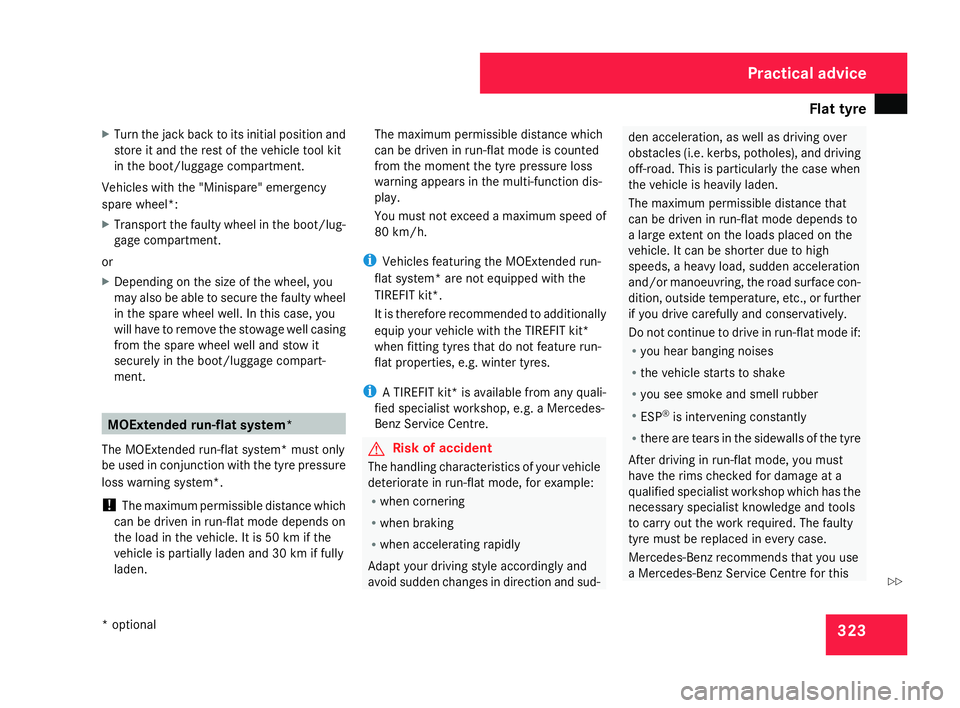
Flat tyre
323
X
Turn the jack back to its initial position and
store it and the rest of the vehicle tool kit
in the boot/luggage compartment.
Vehicles with the "Minispare" emergency
spare wheel*:
X Transport the faulty wheel in the boot/lug-
gage compartment.
or
X Depending on the size of the wheel, yo u
may also be able to secure the faulty whee l
in the spare wheel well. In this case, you
will have to remove the stowage well casin g
from the spare wheel well and stow it
securely in the boot/luggage compart-
ment. MOExtended run-flat system*
The MOExtended run-flat system* must only
be used in conjunction with the tyre pressure
loss warning system*.
! The maximum permissible distance which
can be driven in run-flat mode depends on
the load in the vehicle. It is 50 km if the
vehicle is partially laden and 30 km if fully
laden. The maximum permissible distance which
can be driven in run-flat mode is counted
from the moment the tyre pressure loss
warning appears in the multi-function dis-
play.
You must not exceed a maximum speed of
80 km/h.
i Vehicles featuring the MOExtended run-
flat system* are not equipped with the
TIREFIT kit*.
It is therefore recommended to additionally
equip your vehicle with the TIREFIT kit*
when fitting tyres that do not feature run-
flat properties, e.g. winter tyres.
i A TIREFIT kit* is available from any quali-
fied specialist workshop, e.g. a Mercedes-
Benz Service Centre. G
Risk of accident
The handling characteristics of your vehicl e
deteriorate in run-flat mode, for example:
R when cornering
R when braking
R when accelerating rapidly
Adapt your driving style accordingly and
avoid sudden changes in direction and sud- den acceleration, as well as driving over
obstacles (i.e. kerbs, potholes), and driving
off-road. This is particularly the case when
the vehicle is heavily laden .
The maximum permissible distance that
can be driven in run-flat mode depends to
a large extent on the loads placed on the
vehicle. It can be shorter due to high
speeds, a heavy load, sudden acceleration
and/or manoeuvring, the road surface con-
dition, outside temperature, etc., or further
if you drive carefully and conservatively.
Do not continue to drive in run-flat mode if:
R you hear banging noises
R the vehicle starts to shake
R you see smoke and smell rubber
R ESP ®
is intervening constantly
R there are tears in the sidewalls of the tyr e
After driving in run-flat mode, you must
have the rims checked for damage at a
qualified specialist workshop which has the
necessary specialist knowledge and tools
to carry out the work required. The faulty
tyre must be replaced in every case.
Mercedes-Benz recommends that you use
a Mercedes-Benz Service Centre for this Practical advice
* optional
204_AKB; 2; 3, en-GB
mkalafa,
2007-06-26T23:11:51+02:00 - Seite 323 Z
Page 327 of 377
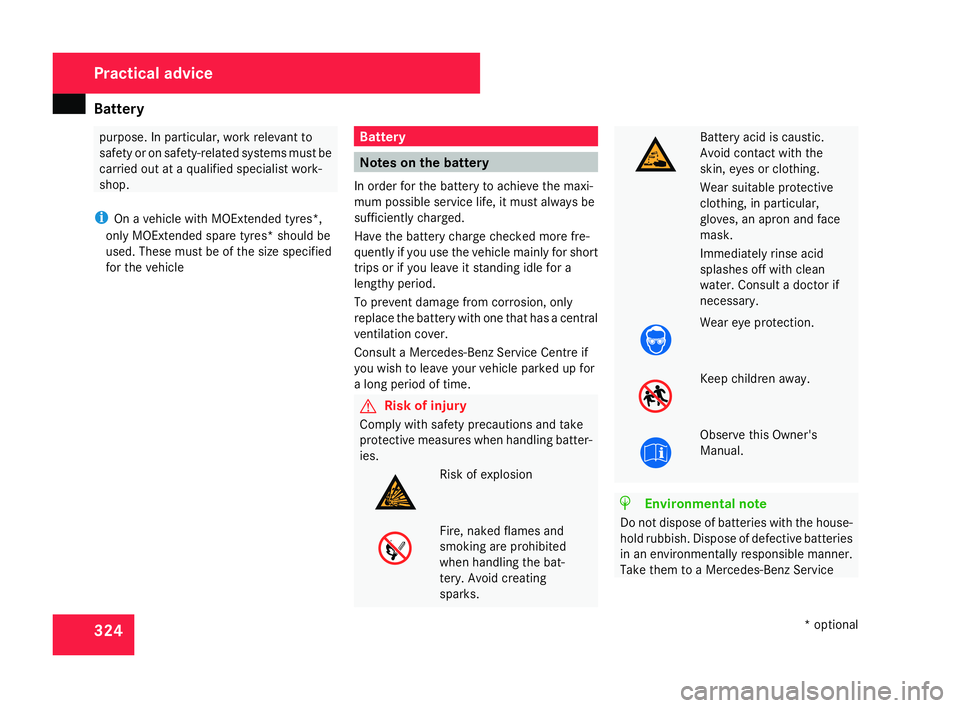
Battery
32
4 purpose. In particular, work relevant to
safety or on safety-related systems must be
carried out at a qualified specialist work-
shop.
i On a vehicle with MOExtended tyres*,
only MOExtended spare tyres* should be
used. These must be of the size specified
for the vehicle Battery
Notes on the battery
In order for the battery to achieve the maxi-
mum possible service life, it must always be
sufficiently charged .
Have the battery charge checked more fre-
quently if you use the vehicle mainly for shor t
trips or if you leave it standing idle for a
lengthy period.
To prevent damage from corrosion, only
replace the battery with one that has a central
ventilation cover.
Consult a Mercedes-Benz Service Centre if
you wish to leave your vehicle parked up for
a long period of time. G
Risk of injury
Comply with safety precautions and take
protective measures when handling batter-
ies. Risk of explosion
Fire, naked flames and
smoking are prohibited
when handling the bat-
tery. Avoid creating
sparks. Battery acid is caustic.
Avoid contact with the
skin, eyes or clothing
.
Wear suitable protective
clothing, in particular,
gloves, an apron and face
mask.
Immediately rinse acid
splashes off with clean
water. Consult a doctor if
necessary. Wear eye protection
. Keep children away.
Observe this Owner's
Manual.
H
Environmental not
e
Do not dispose of batteries with the house-
hold rubbish. Dispose of defective batteries
in an environmentally responsible manner.
Take them to a Mercedes-Benz Service Practical advice
* optional
204_AKB; 2; 3, en-G
B
mkalafa , 2007-06-26T23:11:51+02:00 - Seite 324
Page 328 of 377
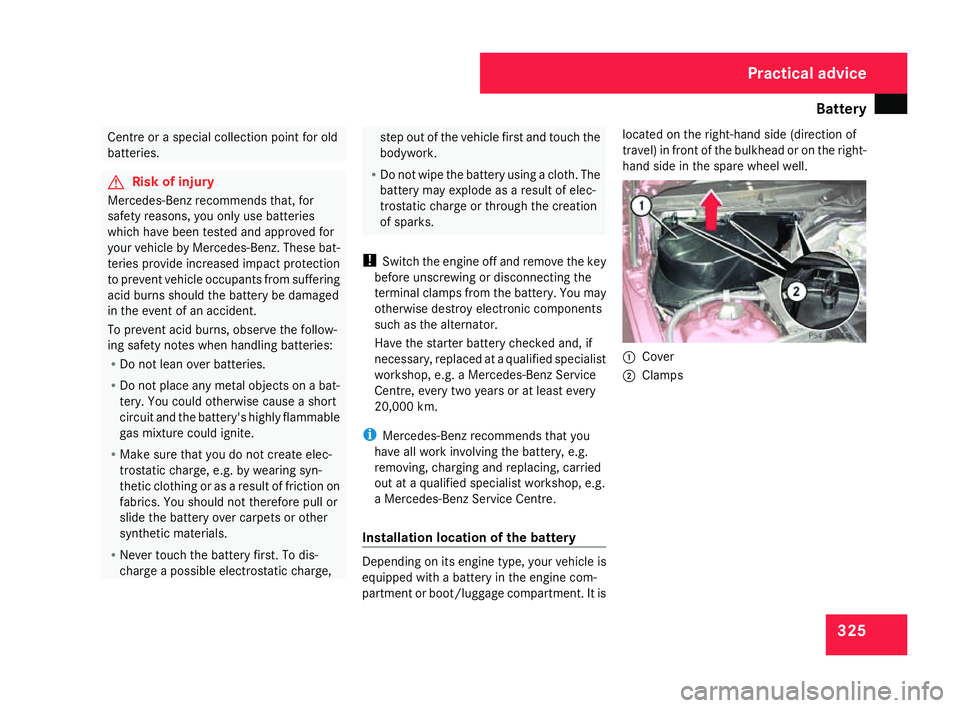
Battery
32
5 Centre or a special collection point for old
batteries . G
Risk of injury
Mercedes-Benz recommends that, for
safety reasons, you only use batteries
which have been tested and approved for
your vehicle by Mercedes-Benz. These bat-
teries provide increased impact protectio n
to prevent vehicle occupants from suffering
acid burns should the battery be damage d
in the event of an accident .
To prevent acid burns, observe the follow-
ing safety notes when handling batteries:
R Do not lean over batteries .
R Do not place any metal objects on a bat-
tery. You could otherwise cause a short
circuit and the battery's highly flammabl e
gas mixture could ignite.
R Make sure that you do not create elec-
trostatic charge, e.g. by wearing syn-
thetic clothing or as a result of friction on
fabrics. You should not therefore pull or
slide the battery over carpets or other
synthetic materials.
R Never touch the battery first. To dis-
charge a possible electrostatic charge, step out of the vehicle first and touch the
bodywork.
R Do not wipe the battery using a cloth. Th e
battery may explode as a result of elec-
trostatic charge or through the creation
of sparks .
! Switch the engine off and remove the key
before unscrewing or disconnecting the
terminal clamps from the battery. You may
otherwise destroy electronic components
such as the alternator.
Have the starter battery checked and, if
necessary, replaced at a qualified specialist
workshop, e.g. a Mercedes-Benz Service
Centre, every two years or at least every
20,000 km.
i Mercedes-Benz recommends that you
have all work involving the battery, e.g.
removing, charging and replacing, carried
out at a qualified specialist workshop, e.g.
a Mercedes-Benz Service Centre.
Installation location of the battery Depending on its engine type, your vehicle is
equipped with a battery in the engine com-
partment or boot/luggage compartment. It islocated on the right-hand side (direction of
travel) in front of the bulkhead or on the right-
hand side in the spare wheel well.
1
Cove r
2 Clamps Practical advice
204_AKB; 2; 3, en-GB
mkalafa,
2007-06-26T23:11:51+02:00 - Seite 32
5
Page 330 of 377
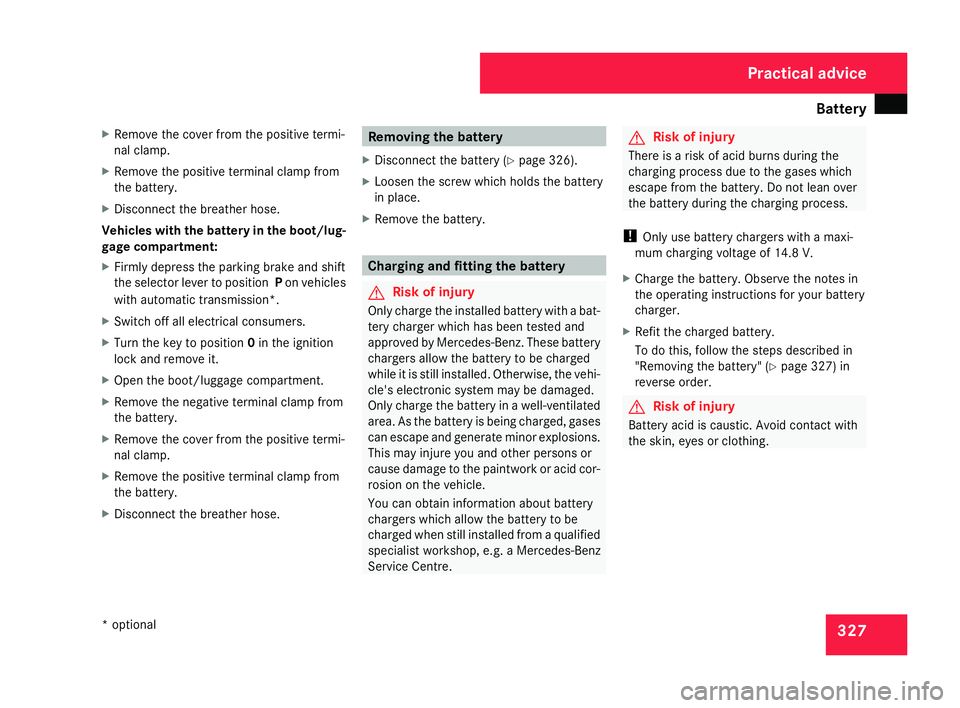
Battery
32
7
X
Remove the cover from the positive termi-
nal clamp.
X Remove the positive terminal clamp from
the battery.
X Disconnect the breather hose .
Vehicles with the battery in the boot/lug -
gage compartment :
X Firmly depress the parking brake and shift
the selector lever to position Pon vehicles
with automatic transmission*.
X Switch off all electrical consumers .
X Turn the key to position 0in the ignition
lock and remove it.
X Open the boot/luggage compartment.
X Remove the negative terminal clamp from
the battery.
X Remove the cover from the positive termi-
nal clamp.
X Remove the positive terminal clamp from
the battery.
X Disconnect the breather hose . Removing the battery
X Disconnect the battery (Y page 326).
X Loosen the screw which holds the battery
in place.
X Remove the battery. Charging and fitting the batter
y G
Risk of injury
Only charge the installed battery with a bat-
tery charger which has been tested and
approved by Mercedes-Benz. These battery
chargers allow the battery to be charge d
while it is still installed. Otherwise, the vehi -
cle's electronic system may be damaged.
Only charge the battery in a well-ventilate d
area. As the battery is being charged, gases
can escape and generate minor explosions.
This may injure you and other persons or
cause damage to the paintwork or acid cor-
rosion on the vehicle .
You can obtain information about battery
chargers which allow the battery to be
charged when still installed from a qualified
specialist workshop, e.g. a Mercedes-Ben z
Service Centre. G
Risk of injury
There is a risk of acid burns during the
charging process due to the gases which
escape from the battery. Do not lean ove r
the battery during the charging process.
! Only use battery chargers with a maxi-
mum charging voltage of 14.8 V.
X Charge the battery. Observe the notes in
the operating instructions for your battery
charger.
X Refit the charged battery.
To do this, follow the steps described in
"Removing the battery" (Y page 327) in
reverse order. G
Risk of injury
Battery acid is caustic. Avoid contact with
the skin, eyes or clothing . Practical advice
* optional
204_AKB; 2; 3, en-GB
mkalafa,
2007-06-26T23:11:51+02:00 - Seite 327
Page 331 of 377
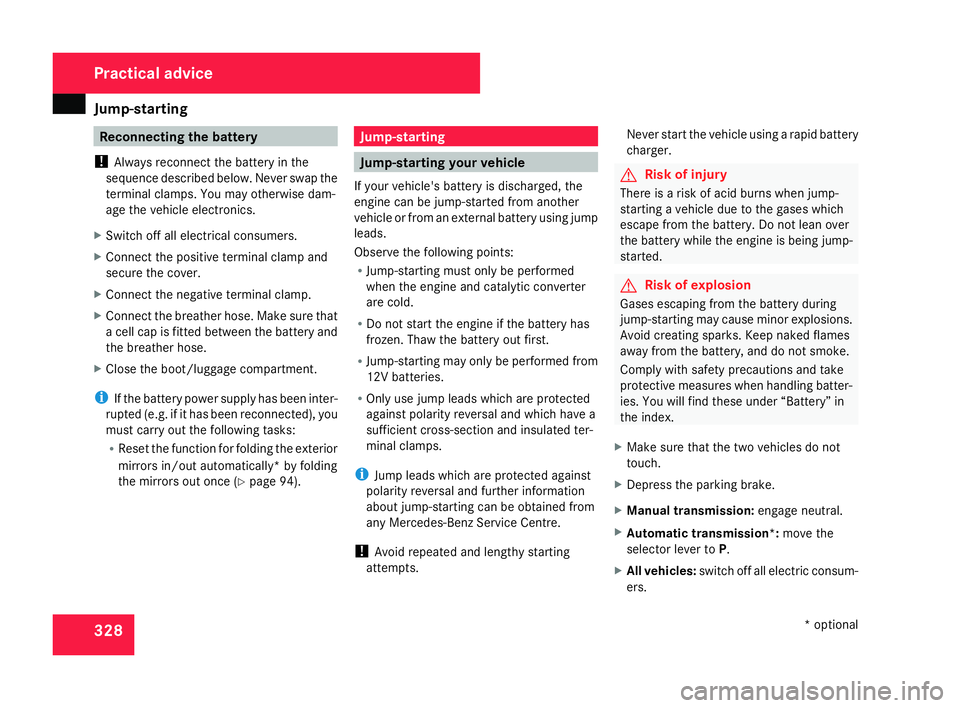
Jump-starting
328 Reconnecting the battery
! Always reconnect the battery in the
sequence described below. Never swap the
terminal clamps. You may otherwise dam-
age the vehicle electronics.
X Switch off all electrical consumers .
X Connect the positive terminal clamp and
secure the cover .
X Connect the negative terminal clamp.
X Connect the breather hose. Make sure that
a cell cap is fitted between the battery and
the breather hose.
X Close the boot/luggage compartment.
i If the battery power supply has been inter-
rupted (e.g. if it has been reconnected), you
must carry out the following tasks:
R Reset the function for folding the exterio r
mirrors in/out automatically* by folding
the mirrors out once (Y page 94). Jump-starting
Jump-starting your vehicle
If your vehicle's battery is discharged, the
engine can be jump-started from another
vehicle or from an external battery using jump
leads.
Observe the following points:
R Jump-starting must only be performed
when the engine and catalytic converte r
are cold.
R Do not start the engine if the battery ha s
frozen. Thaw the battery out first.
R Jump-starting may only be performed from
12V batteries .
R Only use jump leads which are protected
against polarity reversal and which have a
sufficient cross-section and insulated ter-
minal clamps.
i Jump leads which are protected against
polarity reversal and further informatio n
about jump-starting can be obtained from
any Mercedes-Benz Service Centre.
! Avoid repeated and lengthy starting
attempts. Never start the vehicle using a rapid battery
charger. G
Risk of injury
There is a risk of acid burns when jump -
starting a vehicle due to the gases which
escape from the battery. Do not lean over
the battery while the engine is being jump-
started. G
Risk of explosion
Gases escaping from the battery during
jump-starting may cause minor explosions.
Avoid creating sparks. Keep naked flames
away from the battery, and do not smoke .
Comply with safety precautions and tak e
protective measures when handling batter-
ies. You will find these under “Battery” in
the index .
X Make sure that the two vehicles do not
touch.
X Depress the parking brake.
X Manual transmission: engage neutral.
X Automatic transmission*: move the
selector lever to P.
X All vehicles: switch off all electric consum-
ers . Practical advice
* optional
204_AKB; 2; 3, en-GB
mkalafa,
2007-06-26T23:11:51+02:00 - Seite 328
Page 332 of 377

Towing and tow-startin
g 329
The positive and negative contacts are loca-
ted on the front bulkhead on the right-han d
side of the vehicle. 1
Positive terminal of donor batter y
2 Cove r
3 Positive contact on your vehicle
4 Negative contact on your vehicle
5 Negative terminal of donor battery
X Slide cap 2of positive contact 3in the
direction of the arrow.
X Attaching the jump-start cable to the donor
battery first, connect positive terminal 1
of the donor battery and positive contact
on your vehicle 3.
X Start the engine of the donor vehicle and
run it at idling speed . X
Attaching the jump-start cable to the donor
battery first, connect negative terminal 5
of the donor battery and negative contact
on your vehicle 4.
X Start the engine.
X Electrical consumers can be switched on
again. Do not switch the lights on however ,
as this will overload the battery.
X First disconnect the jump lead from nega -
tive terminals 4and 5, then from positiv e
terminals 1and 3.
X Have the battery checked at a qualified
specialist workshop, e.g. a Mercedes-Benz
Service Centre. Towing and tow-starting
Points to remember
G
Risk of accident
If you tow the vehicle, you must use a rigid
towing bar if:
R the engine is not running
R there is a brake system malfunctio n
R the voltage supply or the vehicle's elec-
trical system is damage d
There is no power assistance for the steer-
ing when the engine is not running.
It is better to have the vehicle transported
than to have it towed.
When towing, observe the legal requirement s
in all countries concerned.
! You may tow the vehicle for a maximum
of 50 km. A towing speed of 50 km/h must
not be exceeded.
With towing distances over 50 km, the
entire vehicle needs to be lifted up and
transported.
! Only secure the tow cable or towing bar
to the towing eyes. You may otherwise
damage the vehicle. Practical advice
204_AKB; 2; 3, en-GB
mkalafa,
2007-06-26T23:11:51+02:00 - Seite 329
Page 333 of 377
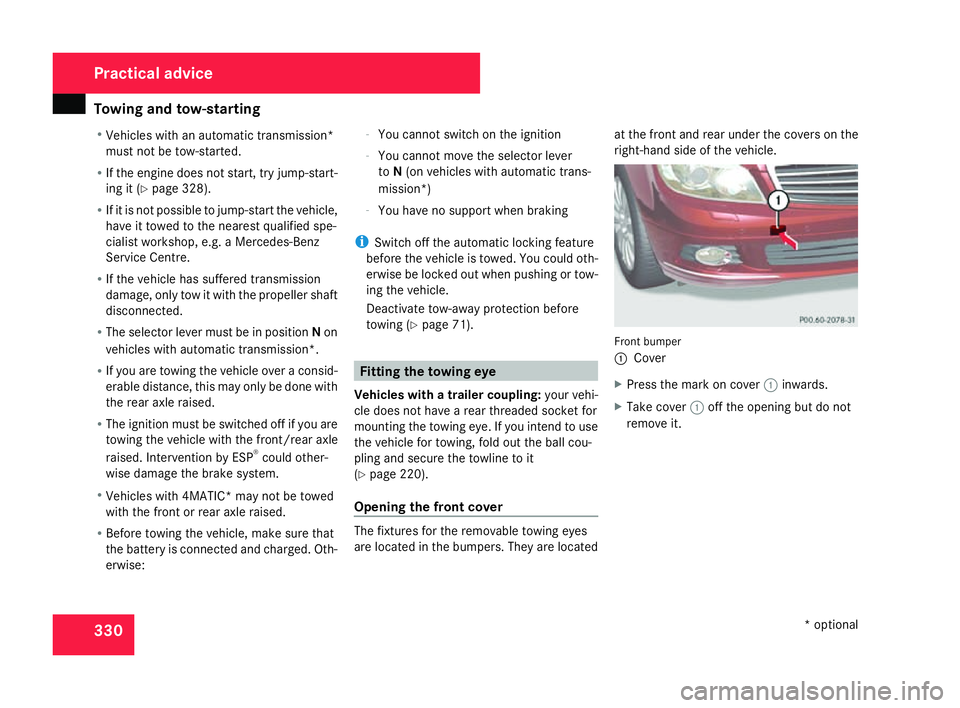
Towing and tow-startin
g330
R
Vehicles with an automatic transmission*
must not be tow-started.
R If the engine does not start, try jump-start-
ing it (Y page 328).
R If it is not possible to jump-start the vehicle ,
have it towed to the nearest qualified spe-
cialist workshop, e.g. a Mercedes-Ben z
Service Centre.
R If the vehicle has suffered transmission
damage, only tow it with the propeller shaft
disconnected.
R The selector lever must be in position Non
vehicles with automatic transmission*.
R If you are towing the vehicle over a consid-
erable distance, this may only be done with
the rear axle raised.
R The ignition must be switched off if you are
towing the vehicle with the front/rear axle
raised. Intervention by ESP ®
could other-
wise damage the brake system.
R Vehicles with 4MATIC* may not be towed
with the front or rear axle raised.
R Before towing the vehicle, make sure that
the battery is connected and charged. Oth-
erwise : -
You cannot switch on the ignition
- You cannot move the selector lever
to N(on vehicles with automatic trans-
mission*)
- You have no support when braking
i Switch off the automatic locking feature
before the vehicle is towed. You could oth-
erwise be locked out when pushing or tow -
ing the vehicle.
Deactivate tow-away protection befor e
towing (Y page 71). Fitting the towing eye
Vehicles with a trailer coupling: your vehi-
cle does not have a rear threaded socket for
mounting the towing eye. If you intend to use
the vehicle for towing, fold out the ball cou-
pling and secure the towline to it
( Y page 220).
Opening the front cover The fixtures for the removable towing eyes
are located in the bumpers. They are locatedat the front and rear under the covers on the
right-hand side of the vehicle.
Front bumper
1
Cove r
X Press the mark on cover 1inwards.
X Take cover 1off the opening but do not
remove it. Practical advice
* optional
204_AKB; 2; 3, en-GB
mkalafa,
2007-06-26T23:11:51+02:00 - Seite 330
Page 335 of 377
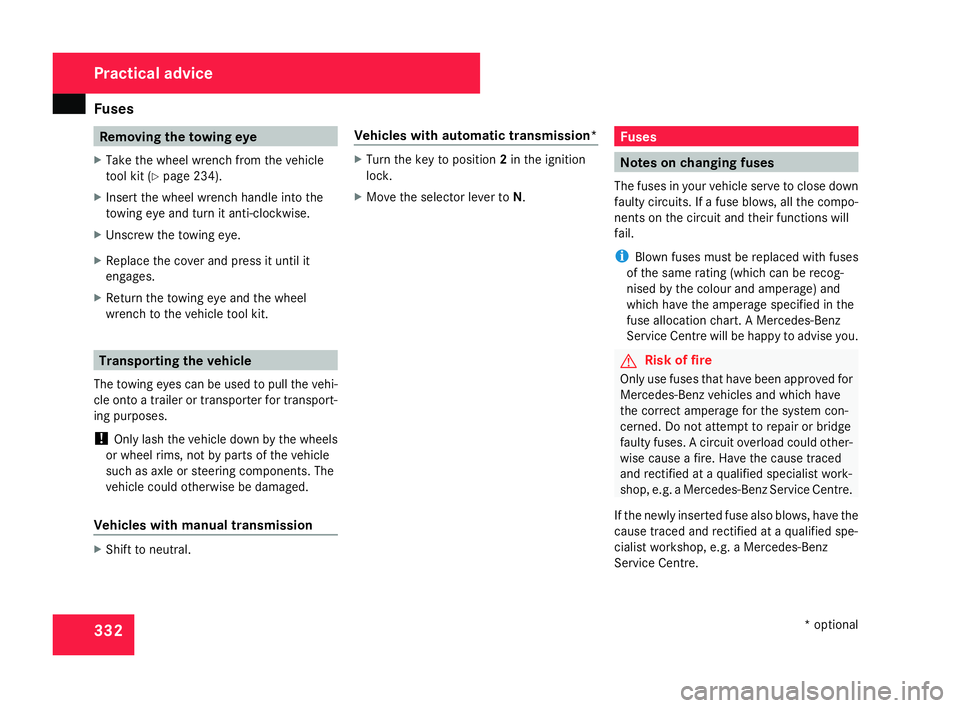
Fuse
s 332 Removing the towing eye
X Take the wheel wrench from the vehicle
tool kit (Y page 234).
X Insert the wheel wrench handle into the
towing eye and turn it anti-clockwise.
X Unscrew the towing eye.
X Replace the cover and press it until it
engages.
X Return the towing eye and the whee l
wrench to the vehicle tool kit .Transporting the vehicle
The towing eyes can be used to pull the vehi-
cle onto a trailer or transporter for transport-
ing purposes.
! Only lash the vehicle down by the wheels
or wheel rims, not by parts of the vehicl e
such as axle or steering components. The
vehicle could otherwise be damaged.
Vehicles with manual transmission X
Shift to neutral . Vehicles with automatic transmission
* X
Turn the key to position 2in the ignition
lock .
X Move the selector lever to N. Fuses
Notes on changing fuses
The fuses in your vehicle serve to close down
faulty circuits. If a fuse blows, all the compo -
nents on the circuit and their functions will
fail .
i Blown fuses must be replaced with fuses
of the same rating (which can be recog -
nised by the colour and amperage) and
which have the amperage specified in the
fuse allocation chart. A Mercedes-Benz
Service Centre will be happy to advise you. G
Risk of fire
Only use fuses that have been approved for
Mercedes-Benz vehicles and which have
the correct amperage for the system con-
cerned. Do not attempt to repair or bridge
faulty fuses. A circuit overload could other-
wise cause a fire. Have the cause trace d
and rectified at a qualified specialist work -
shop, e.g. a Mercedes-Benz Service Centre.
If the newly inserted fuse also blows, have the
cause traced and rectified at a qualified spe-
cialist workshop, e.g. a Mercedes-Benz
Service Centre. Practical advice
* optional
204_AKB; 2; 3, en-GB
mkalafa,
2007-06-26T23:11:51+02:00 - Seite 332